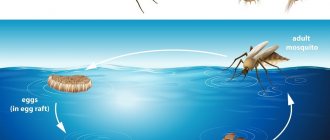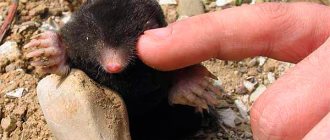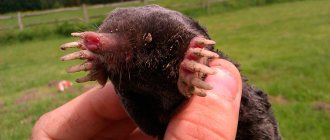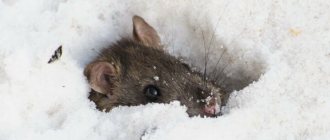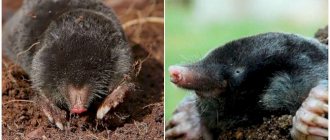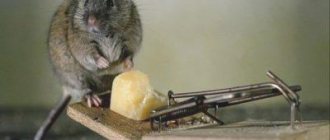Next you will learn:
- Do moles hibernate like many other animals, or is this a myth;
- How moles winter, and what helps them survive the cold season;
- Do moles store food for the winter and continue to dig under the snow in search of new food;
- Is it worth leaving mole protection on the site for the winter, or does it not make sense?
...And also a number of other interesting nuances regarding the wintering features of moles.
Winter is a very difficult period for moles - during the cold season, these animals have to mobilize all their resources in order to survive, so they carefully prepare for wintering. However, even despite this, in some years many moles die without surviving until spring.
For many gardeners and owners of a summer cottage, the question of how exactly a mole overwinters is of practical importance, allowing you to competently organize the protection of a garden or a resting garden from these animals - we will also talk about this a little later.
Kinds
There are currently more than 30 different species of moles. The main four types that are quite common are:
- Blind mole (small);
- Caucasian;
- Siberian;
- European.
Because they spend most of their time underground, they have very small eyes and ears that are almost entirely covered in fur. Their most distinctive feature is their powerful paddle-shaped front end with large, thick toenails that they use to dig their tunnels.
Let's take a closer look below:
- Do moths hibernate;
- What helps moles survive in the cold season;
- Are they able to collect supplies for the winter and continue to dig under the snow in search of new food?
We protect our possessions
Since moles are active in winter and their lifestyle remains almost unchanged, summer residents and gardeners are not happy with such a neighborhood.
What harm does this little animal cause:
- destroys beneficial earthworms in a state of suspended animation;
- underground passages violate the integrity of the garden;
- breaking through new passages, they cause damage to wintering plants, for example, garlic, onions, beets, etc.
In the cold season, under the snow, this activity is not noticeable, but it will become a big unpleasant surprise in the spring.
Therefore, in order to protect your garden from uninvited guests, it is recommended to leave ultrasonic or homemade repellers on all winter. In addition, it is worth keeping traps, nets and trenches against moles for the winter.
Video at home “What does a mole do in winter”
Owners of large plots of land on which crops are grown often have problems due to the appearance of moles. Since these animals complicate the growth of cultivated plants in summer and autumn, there is nothing to harm them in winter, but gardeners are interested in whether moles hibernate in winter. In this article we will provide information about how moles overwinter, how they hibernate, what they do in winter, what they eat. Contents
- 1 What is hibernation in moles
- 2 Video at home “What does a mole do in winter”
- 3 How he lives
- 4 What does it eat?
- 5 Video at home “Life activity of the common mole”
From the video you will find out what this animal does during the cold season.
From the video you will learn how this animal lives.
Shrew conservation
The situation with forest shrews today is very unfavorable; this species is considered endangered. Eisentraut's mouse shrew and Rampian mouse shrew are also endangered. All these mentioned species are listed in the Red Book of the International Union for Conservation of Nature.
The giant shrew is listed in the Red Book of the Russian Federation; it is considered the rarest relict species, the number of which has decreased significantly over the past two centuries.
Basically, the reason that some species of shrews are classified as endangered is the large-scale deforestation of forests, the occupation of lands where animals lived for agricultural needs, and the expansion of the construction of human settlements. All this adversely affects the numbers of many animals, including the shrew family.
In the end, it remains to add that the life of a miniature shrew is very short, but very intense and interesting. By going into its details, you can learn a lot of new and unusual things. The main mistake of many is mistaking it for an ordinary mouse, but the shrew is not a rodent at all, but the smallest and tireless predator, which is a threat to countless insect pests.
The myth about hibernation of moles
Many homeowners assume that moles hibernate and are not active during the winter months, but this is not true. Their main permanent tunnels and nesting burrows are dug deep underground below the frost line, allowing the mammals to remain active during the cold winter months. In winter, they stop digging surface tunnels in the soil as the ground freezes. Since people cannot see these surface tunnels, they believe that the moles are hibernating and are not causing damage to their lawns, gardens, or gardens.
In winter, moles do not hibernate because they cannot store fat on their bodies, since it is quite cold outside. Instead, they follow earthworms deep into the ground to stay warm and well fed during the cold winter months. Afterwards, they lie patiently waiting for the warm weather to return and appear like clockwork to continue its vicious cycle of wreaking havoc in yards and gardens everywhere.
To rid your garden of moles, you need to choose a specific method of fighting them. Before doing this, you should carefully read the various methods and know all their advantages and disadvantages. Some will choose to fight the invasion of these animals with store-bought tools. Someone will decide to use popular folk remedies that you can make yourself.
Hedgehogs and gophers in cold weather
Hibernation in small mammals, such as hedgehogs, ground squirrels, marmots and many others, differs from the sleepy state in which large animals remain. All life processes of babies slow down and become much weaker. Their sleep is characterized by the following signs:
- the pulse drops sharply;
- oxygen consumption is reduced by 40−60 times;
- body temperature drops to almost 0 ºС.
This adaptation mechanism allows you to save life and survive the winter without food in a cold, tightly sealed hole, into which there is practically no oxygen. Winter sleep in small animals proceeds differently.
Hedgehogs that eat insects hibernate when the weather gets cold and food runs out. They prepare for winter in advance: they eat heavily and gain fat. At the same time, they are looking for winter shelters, improving and insulating them. This is very important, because if the place for hibernation is chosen incorrectly, the animal will die.
Hedgehogs either dig deep holes for themselves, or nest under sheds, in dense bushes, under tree roots. They cover their shelters with a thick layer of leaves, so the temperature there does not drop below zero. Hedgehogs sleep deeply and lasts up to 240 days. The animals sleep curled up in a ball, pressing their paws and nose to their abdomen. They wake up in April, when the frosts end.
Gophers, which mainly feed on green matter, also fall asleep in their burrows in winter. These amazing animals have very deep sleep, which lasts up to 8 months. In the steppes, where many gophers live, winter temperatures sometimes drop to -50 ºС. At this time, their burrows freeze to -5 ºС, and the temperature in the animals themselves drops to -2 ºС. But gophers do not die; they survive safely until warm days.
As scientists have found, the animals' continuous sleep lasts about 3 weeks. The little rodent then wakes up to urinate and stretch, and then goes back to sleep. In a frozen state, his pulse rate drops from 200-300 to 1-4 beats per minute. Breathing becomes episodic: the animal takes 5-10 breaths, then does not breathe at all for an hour. Scientists joke that at this time the gopher looks like a potato from a cellar: hard, cold, only shaggy. But as soon as it gets warmer and the snow melts, the rodent comes to life and crawls out. It basks in the spring sun and eats heavily after the winter hunger strike.
Let's get to know the digger better
The mole is a representative of insectivorous mammals, adapted to a burrowing, underground lifestyle. Depending on the species, the body size of this animal varies from 5 to 20 cm.
A few words should be said about the peculiarity of his fur coat. The mole's pile is short, soft, grows straight and lies freely in different directions, which allows the little animal to move freely underground in any direction.
The animal sets up a nesting chamber at a depth of up to 2 meters and insulates it.
Description of the shrew
A small animal whose body reaches a maximum of seven centimeters, with gray-brown or light brown fur, an elongated elongated nose, and a long thickened tail - this is a shrew.
From a distance it resembles a mouse, but upon examining it up close, it becomes clear that this is not a mouse at all, but a special species of the smallest mammal that lives in the ground. The shrew rat can also live in the ground. Many shrews are mistakenly attributed to the rat family. But the shrew rat is very large. Her body size can reach twenty-five centimeters.
In the video below, you can clearly see the nimble animal.
Are there any benefits to mole tunnels?
Moles dig tunnels and nest in the deep depths of the earth (they will not be visible on the surface of the earth). In addition, they also dig shallow tunnels beneath the surface of the earth on a daily basis as they search for earthworms and insects to feed on. Thanks to this, they rid the garden of pest larvae. When people see such tunnels, they immediately associate them with shrews.
Moles do not reuse these temporary tunnels and simply continually dig new ones every day in search of food. Unfortunately, this habit causes great damage to your lawn and garden. Since while digging a new tunnel, these cute animals harm the root system of vegetable and garden plants.
How to get rid of shrews using folk remedies
She has a lot in common with her brothers. Many methods work well for eliminating moles and voles.
Repellers
Many people know about the existence of electronic ultrasonic repellers, which have a negative effect on rodents, and not only on them. The only problem is that such products act not only on pests, but also on pets. At the same time, many experts point out that ultrasonic waves, under certain conditions, have a negative effect on humans. In addition, animals that are located deep in the ground are unlikely to be “treated” with these devices.
Magnetic resonance repellers
Often, the functions of an ultrasonic repeller also include a magnetic resonance function. In other words, the device creates a magnetic force field that negatively affects the animals. As a result of this action, the pests develop a feeling of panic, as they lose orientation in space. As a result, after some time, they move to another area.
Basically, these are compact devices that can operate both from batteries and from the mains. They have a directional effect, so the device can be installed on an outbuilding, in the direction of the garden.
Buying such a device requires studying its characteristics so as not to harm pets and humans.
Mechanical repellers
These types of repellers are easy to manufacture and do not require additional costs. To do this, you need to take wooden sticks, dig them in the garden (hammer them) and hang cans on them. Under the influence of the wind, they will hit each other, creating noise. The noise is transmitted along the stick into the ground, which creates uncomfortable conditions for the life of the animals.
The method, although simple, has its drawbacks. The main disadvantage is the noise, which affects not only animals, but also humans, and especially neighbors.
Unbearable odors
They not only scare away animals, but also make it difficult to find food. They find it using their sense of smell. If the smell of prey is interrupted by another irritant, hunting will become impossible.
You should not use aggressive chemicals - they can poison the soil and cause more harm to the plants than a huge colony. You can put old rags soaked in gasoline or kerosene in the hole. Fish giblets or head will do. Spoiled fish quickly decomposes in the soil. Its smell will not be noticeable on the surface. So that it spreads faster inside and does not leak out, the entrance is covered with soil.
Mint, wormwood, spurge, as well as peas, lentils and beans help cope with the problem. They are placed in passages or planted along the fence to protect against the penetration of pests.
The advantage of the method is its environmental friendliness. Fish offal, leaves and grains decompose well in the soil. The disadvantage is that the animal may come back when the stimulus stops working.
Noise repellers
The sound must penetrate the soil. On the surface it will be of little use. The design of a homemade repeller is very simple. A long reinforcing rod is dug in a meter deep, and a tin can with the top cut out is placed on top of it. By hitting the walls against the rod, it creates vibrations that cause anxiety in the animal.
They also cut propellers out of aluminum or create rotating scarers from plastic bottles. 3-4 vertical cuts are made on their walls from the bottom to the neck. Two more horizontal cuts are made from the top and bottom edges. The plates obtained in this way are folded to the side. The device resembles a rotary fan. The embedded rod should be inside the bottle. It is put on top of it with its neck, and the pin rests on the center of its bottom. The blades should be parallel to the rod.
The main disadvantage of the method is that the noise disturbs not only pests, but also humans. In addition, homemade propellers only work in windy weather. Animals perceive it differently. Some individuals gradually get used to it and stop noticing it.
Domestic cats and dogs
Pets do an excellent job. The main thing is that they have a desire to hunt. If there are pets on the premises, toxic substances should never be used. Even if the pet does not find the poisoned food first, it can be poisoned by a mole or rodent that has tasted the poison-soaked food.
Tap water hose
The holes are filled with a hose. They are not always connected to each other, so you need to water the entire area. The flow will drive pests to the surface and destroy some of the underground passages. It is important not to overdo it and not flood yourself and your neighbors. If drainage is poor, moisture will remain for a long time and will destroy even plants that tolerate dampness well. Their root system will be completely flooded.
This solution should not be used too often, so as not to wash away the fertile soil layer.
Planting marigolds on the site
Among the tips on how to deal with shrews in your summer cottage, you can also find more humane methods - for example, simply planting marigolds. Shrews cannot tolerate them. Flowers can be planted along the fence for prevention. Oddly enough, this method works. A colony that has entered the territory is removed by pouring petals into the holes.
Mesh embedded along the fence
The mesh should be buried around the perimeter of the entire plot by at least 1.2 m, leaving 10-20 cm on top. The width of the cell is no more than 1 cm. The work will take a lot of time, but not a single pest will overcome such an obstacle. It is more convenient to install it when building a fence.
Carbon steel mesh will quickly rust. Galvanized is expensive. Plastic is not afraid of moisture, but it is easy to chew through. It is better to use aluminum and galvanized steel.
What does it eat?
In winter, the mole cannot hibernate, so it needs to eat normally in order to maintain the normal functioning of its body.
For an animal to feel full, it needs to consume at least 80-90 grams of food per day. Without food, an adult mole can live up to 18-19 hours, and babies even less. Therefore, these pests are constantly looking for a place where they can find food.
It is generally accepted that it is the feeling of hunger that increases the activity of the animal, both in the spring and with the onset of cold weather. Digging out a large number of underground passages, this mammal spends a lot of strength and energy.
As at any other time, the diet consists of earthworms, various insects, as well as their larvae, beetles, snails and similar living creatures.
A mouse or shrew can get into the wide branching system. They often use passages that were dug by a predator. If she finds herself in a dead end, she will become food for the mole. It can also eat rodents that have died from starvation, since these animals can also eat carrion.
Despite the big appetite of the burrowing animal, it is able to prepare food for itself for the winter. Earthworms are used primarily for harvesting. The mole bites off the head of the worm, and the back part remains lying in its tunnels. Sometimes separate rooms may be used to store supplies. Otherwise, throughout its entire system of underground passages there will be remains of worms, which the predator will eat if there is a shortage of food.
After conducting research, scientists carefully studied the approach of these animals in preparation for wintering. More than five hundred stored worms were discovered, which were found in the mole's nest or tunnels. Of course, this will not be enough for the animal to feed all winter, but it will make it much easier for him to survive during cold weather for some time, since it is difficult to find food in winter.
Animal diet
What does a mole eat in winter? Since in winter the animal’s physical activity is still less than in summer, there is no need to feed the cubs, and there is no sexual activity, less energy is spent, which means the need for food is reduced.
Of course, prepared food reserves allow him to rest a little more in winter and eat less, but this does not mean that he will stop his hunt. Deep underground, moles feed on all living creatures that can be found there.
These seemingly harmless little animals are even called “underground crocodiles” because of their gluttony and the structure of their teeth - they eat everything in their path.
The main delicacies for them are earthworms and insect larvae (for example, chafers and mole crickets). Any shrew or mouse you encounter will not survive either. These predators also do not disdain the corpses of rodents. Some species can eat at one time approximately as much food as their own weight.
In the warm season, small predators stock up on earthworms. With one bite, they gnaw the body of the worm into two halves, eat one, and hide the other for the winter.
Similar reserves can be found throughout the branched underground passages - moles feed on them during their “winter raids”.
The special structure of the front legs and claws allows the animal to rake even frozen ground to find food. These little underground dwellers break through new passages in order to discover wintering insects, worms or snails on the surface, under rotten leaves.
When is the best time of year to catch moles?
These animals can be captured at almost any time of year and in most weather conditions. There is no specific time when they are easier to catch. Moles dig the same way at any time of the year, but they tend to be more active during the spring, summer and fall. When moles are more active, they use their runs more often and therefore have a greater susceptibility to being caught in a set trap.
The most terrible enemy of a gluttonous mole is hunger. Lack of supplies is the main cause of death for these mammals in winter.
The main methods used to combat moles are:
- Tin can noisemaker;
- Plastic, glass bottles with an open neck;
- Ultrasound;
- Filling the tunnel with water;
- Ammonia, kerosene, castor beans;
- Net.
Dream of brown bears
The most famous animal that sleeps in winter is the brown bear. It is impossible for such a large animal to find food under the snow, so it remains in the den until spring. In the summer, the bear diligently accumulates fat, the thickness of the layer under the skin reaches 10 cm. By winter, he arranges for himself a dry, warm and protected from enemies den, where he can sleep peacefully. For her, the bear chooses the following places:
- hollows and spaces between the roots of forest trees;
- abandoned anthills;
- self-dug dugouts.
A bear's sleep is not as deep as that of other animals. His body temperature hardly drops, all life processes proceed the same as in summer. In winter, a forest bear may give birth to children, whom she cares for.
By the onset of spring, when the bear wakes up, it loses up to half of its own weight. In winter, waking him up is very dangerous, since the awakened bear is extremely angry and aggressive . Such animals are called “connecting rods”. They wander through the forest in vain search for food, suffering from cold and hunger. Connecting rods usually don’t survive until spring.
Ways to fight
The easiest way is to fill the mole holes with water. Of course, in this way you can remove the mole from the garden, but only for a couple of hours, until the mole digs a new tunnel next to the flooded one. The second method, more effective than the first, is to put pressure on the mole’s strong sense of smell and drive it out with the help of pungent odors.
We suggest you read: What does a vole eat: in a meadow, forest, steppe or taiga, is it a herbivore or an omnivore?
To do this, you can use kerosene, mothballs, castor oil and even rotten eggs, anything that gives off an unpleasant odor. For example, you can dilute kerosene in one hundred grams of hot water, wet a rag with it and plug all the mole holes that you can find with it.
But the most effective way to drive moles out of the area is with the help of special ultrasonic devices, which can be bought in specialized stores. The essence of the device is simple: it emits ultrasound, which is unpleasant to animals, which is why moles will be forced to leave the area within the shortest possible time. The only disadvantage of this method is its cost, because such devices are by no means cheap.
Reviews from gardeners
Konstantin, 64 years old, Rostov
The simplest methods helped to scare away shrews from a summer cottage: acoustic and “aromatic”. Before the autumn digging of the garden, dried marigolds crushed into dust were scattered, and rags soaked in turpentine were buried along the entire border of the plot. Pieces of rotten fish were placed in the holes. In case the shrews bypassed the bait, additional metal reinforcement was dug into the garden bed at a slight angle to the ground, to a depth of 40-50 cm. A plastic bottle was placed on it, which moved with a light blow of wind, and the noise from the vibration of the steel rod scared away the animals. Champagne bottles, also at an angle, were buried in the ground - the effect was the same - an unbearable roar was heard.
Veronica, 56 years old, Ryazan region
In the garden plot we did not decide to use poison or traps for humane reasons, so we save ourselves from shrews using the Grad ultrasonic device. I insert batteries into the device, seal it in a plastic bag and dig it near the holes to a depth of 10 cm. After 2-3 weeks I observe the complete disappearance of the pest. At the same time, ultrasonic waves do not have a harmful effect on animals and people.
Semyon, 48 years old, Krasnodar region
In my apiary in mid-November, a shrew got into the habit of emptying the hives. It is more dangerous than ordinary mice because it is small and very voracious. To drive it away, I placed a fine-mesh (size 6 mm) grate between the bottom and the lower body, but the tight holes prevented the bees from exiting. In March I replaced it with a mesh with 8-10 mm cells. In addition, I cleaned the hives of dirt and placed a pollen collector on the entrance. After that, all the problems with pests disappeared.
Why do moles create tunnels and hills?
Moles create tunnels for two purposes, traveling and feeding. Passing tunnels are pathways between feeding areas and the bottom. Feeding areas are usually marked by clusters of mounds and shallow tunnels. Their goal is to help the mole hunt for its main diet, worms. The mounds or "mole hills" are excess dirt that has been mined by the jetty to create these tunnels.
Pest or not?
Does it make sense to drive moles out of your area? Before answering this question, it is necessary to analyze the pros and cons of the appearance of moles on the site.
So, the advantages include:
- The fact that moles contribute to loosening and increased aeration of the soil cover.
- The fact that moles eat all the pests that can live in the gardener’s soil. All possible grasshoppers, mole crickets and even field mice are safely eaten by the mole.
But no matter how many advantages there are in the appearance of moles on the site, the disadvantages are much more serious:
- Moles dig up cultivated soil, thereby disturbing the integrity of the soil cover, which can lead to the death of plants planted in this soil.
- Moles eat worms in the area, which help loosen the soil.
- Moles, while moving, throw up infertile soil, worsening the future harvest.
- Various infections and diseases can be carried by moles and mice (mice, in some cases, can use mole passages to get to bushes, etc.).
These are not all the troubles that a mole can bring, and that is why it needs to be removed from the garden, fortunately, humanity has come up with a lot of ways to do this.
Guilty!
In addition to the aesthetic damage that moles cause to our lawn and flower beds, there are two more big troubles. Moles, in the process of their tunnel-forming activities, may well (unfortunately, do) dig a hole right under your favorite shrub or perennial plant, thus leaving their roots practically hanging in the air. Needless to say, this often leads to the death of the plant. Therefore, if you notice a wilted bush, inspect it carefully. And, if you see traces of the activity of moles, compact the earth harder so that these voids are filled.
Almost the same problem sometimes happens with rolled lawn. In the spring, moles sometimes create a “happy life” under it, leaving the roots of the grass literally dangling in the air. The lawn itself is drying out in this place. If such a misfortune is detected, the lawn must be rolled with a roller or verticutter. It makes sense to remove particularly barbarically damaged turf and add some soil under it.
Habitat
The habitat of moles is the west of Russia, Siberia and the east of the Urals, or rather, their forests and forest-steppe zones. They choose to live in regions with moist soils that are easy to dig and are rich in what moles eat in the forest and in the areas bordering it. The majority of animals lead an underground lifestyle, making tunnels.
Some animals prefer a terrestrial lifestyle, which allows them to find food without much difficulty. True, due to the structural features of the front legs, designed for tearing up the soil, moles have to move only by crawling on land. Deep twilight and night are the hours when these animals are active.
In the steppe and taiga expanses there is not a sufficient amount of what moles feed on in the forest (due to acidic and dry soils). However, they are occasionally found in these zones, colonizing water meadows and river floodplains covered with bushes.
Reproduction
The animals mate in the first days of spring. Offspring appear once a year, not earlier than April-June. In a litter, 3-9 blind and naked cubs are found. The young make quiet sounds similar to a chicken squeak. At first, the cubs are friendly, but over time, aggressive fights arise in the brood.
Month-old moles are difficult to distinguish from adult moles. At this age, the animals begin to leave their mother’s habitat and build their own highways. During the migration period, if necessary, they swim across small rivers.
Feeding the Cubs
The mating season for moles begins in April and lasts until the end of May. Pregnancy lasts about 30 days. The younger generation is born in June-July. Very rarely does a female give birth to two litters in one season. She gives birth to about 9 babies at one time.
In the first week of their existence, moles weigh no more than 5 g, are blind, naked, toothless, and absolutely helpless. For 3 weeks, the diet is exclusively milk. The female carefully looks after them, takes care of them, and protects them from enemies. At the end of the month, young moles begin to eat worms and larvae, and after 60 days they reach the size of an adult animal and are capable of strangling a mouse, lizard, or snake.
Source
